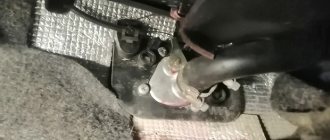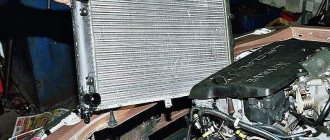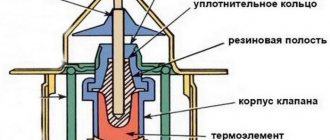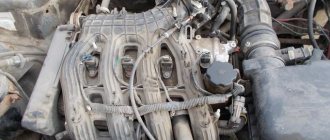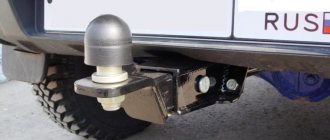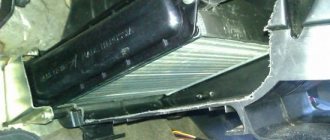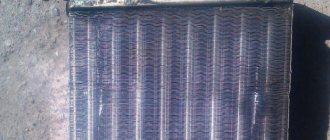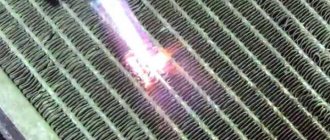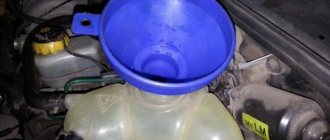The radiator provides cooling of the liquid, which circulates in a large circle. Heat transfer occurs when antifreeze or antifreeze passes through its tubes, which come into contact with air.
Additionally, two fans blow over the engine, each of which turns on at a certain temperature.
On the Niva Chevrolet, the radiator is installed in the front part of the engine compartment; the designers have provided good access for its replacement.
Before dismantling, you need to make sure that the radiator is broken.
Device
The part has a classic design, typical of modern passenger cars: two tanks connected by tubes with cooling plates. The manufacturer took the path of reducing the cost, which was reflected in the materials used. The tanks are made of plastic, the tubes are made of aluminum. the parts are connected through a rubber gasket that prevents coolant leakage.
Chevrolet Niva with and without air conditioning is equipped with one radiator model. The only difference is that in the first case, the condenser of the air conditioning system is fixed in front of the honeycombs, and in the second - a guide casing.
Radiator installation
In the process of dismantling the radiator, you have to go through all the stages that are provided for its installation
It is important not to forget to change the rubber feet (switch to the new radiator from the old one), since the new unit is not equipped with them. When connecting the pipes, you need to remember that it may be necessary to repeat this procedure again, so the clamps should be positioned so that they can be easily unscrewed with a long screwdriver
If you removed the heat exchanger of the hydraulic booster, then air did not enter the power steering compressor, therefore, there is no need to remove it from the system. The air contained in the power steering radiator will escape through the tank.
Having installed the radiator, proceed to piping the thermostat and installing the air filter housing. Since the coolant was drained, the system will have to be refilled. Filling is done through the expansion tank. Since the thermostat is closed, the large circle will be practically empty. The liquid has the opportunity to get into it, but it happens quite slowly. It is easier to warm up the car to operating temperature, and then add fluid to the desired level.
When using a vehicle for a long time, technical failures sooner or later occur.
If you do not pay attention in time to what the car wants to tell you, serious damage may occur that will cause great discomfort in financial terms.
A very important element of the Niva Chevrolet is the cooling system
Naturally, the motor gets very hot while driving. There is an optimal operating temperature at which the engine performs its role without risk of breakdown. But when the cooling system does not fully perform its function, overheating occurs, which entails a malfunction.
Comparison of manufacturers
In stores you can find spare parts produced by several companies. Products differ in two parameters: price and workmanship. Let's look at a few of the most popular brands.
Hola is a trademark of the Dutch company H&H Group. 15 European factories produce radiators, belts, shock absorbers and other auto parts. Inexpensive products of this brand are of good quality. According to customer reviews, spare parts of this brand at a comparable price are superior in quality to Chinese products. Price - 2000 rubles.
DAAZ - Dmitrov Automotive Assembly Plant, part of the United Automotive Technologies concern, was founded back in 1967. In addition to radiators, the company produces filters, brake pads and other spare parts for Russian and foreign cars. The products of this brand are used in cars that come off the AvtoVAZ assembly line. Price - 2500 rubles.
Luzar is a Russian company that was founded in 2003 on the basis of the Lugansk Radiator Plant. Products of this brand comply with GOST-R and the manufacturer gives them a 2-year warranty. Price - from 2100 rubles.
Advantages and disadvantages
The design of the Chevrolet Niva stove is considered successful, since in principle it is similar to the design of the heating system of many foreign cars that are not equipped with air conditioning. In this regard, a number of advantages of such a scheme can be identified.
- Quick heating of the interior. Now there is no need to wait for the thermostat to open. The air becomes warm as soon as the coolant begins to heat up.
- Possibility of engine cooling through the heater radiator. A very common failure in the cooling system is a stuck thermostat. And if a thermostat stuck in the open position does not interfere with getting to the service station, then it is impossible to move the car with the cooling radiator closed. By turning on the heater, you can remove some of the heat and cool the engine somewhat.
- The recirculation mode helps to quickly heat the interior or temporarily stop the penetration of outside air.
The heating system is not without its shortcomings, which clearly manifest themselves.
- The complex system of damper levers often leads to jamming. Some dampers become difficult to adjust over time.
- Leaky duct joints result in loss of airflow. Considering the high noise level of the heater motor, the speed of the air flow entering the cabin through the deflectors is extremely low.
- Almost the entire system is located inside the car, so repair work has to be carried out in limited space.
When to change
Aluminum and plastic are materials that are difficult to repair if cracks or holes appear. Therefore, the main reason for replacing a radiator is a coolant leak.
There are two reasons for replacement:
- coolant leak;
- clogged tubes.
If you notice drops and smudges, you should immediately replace the product with a new one, and not try to eliminate leaks with dubious means for eliminating antifreeze leaks.
Despite advertising claims, various powders added to the coolant do little to eliminate leaks, but they perfectly clog radiator pipes. This reduces its efficiency. In this case, you need to replace the part with a new one. If this is not done, then systematic overheating of the engine will lead to the need for rapid overhaul.
Relay for starting the fan
The spare block may contain not only the fuses themselves, but also electromagnetic relays. They control the operation of the engine cooling system, the circuits of which are powered by the ignition switch of the on-board computer. The current comes from the battery through the fuses themselves.
The relay operates as follows: at the very beginning, voltage is applied to the output, as a result an electromagnetic field is formed by passing current through the inductive coil. Subsequently, the current passing through the relay starts the engine. If the voltage is removed, the contacts will open due to the spring that is present in the mechanism, and the fan itself will stop.
There are several ways to check the operation of the relay. The simplest method is to replace the relay with the same working one and check the condition of the system. Turn off the engine, then disconnect the temperature sensor connector, after which you will hear a characteristic click of the relay. Then you need to remove and test the output contacts using multimeters, constantly applying voltage to the output. From the temperature sensor, information is supplied to the unit switching device.
The temperature sensor itself is a resistor, the values of which vary in a variable temperature range: from 1.3-1.8 Ohms at 30°C to 155-196 Ohms at 90°C. To give an accurate assessment of its performance, use a thermometer and an ohmmeter, calculating the resistance at different temperatures. To check, the part is removed and then immersed in an aqueous environment. The sensor can be found near the main exhaust system. It is dismantled using a spanner.
Replacement on a car without air conditioning
The work is carried out in an inspection ditch. Before starting repairs, you need to prepare a new air conditioner, 10 liters of antifreeze and the following tools:
- Container for draining coolant.
- Spanners.
- Crosshead screwdriver.
- Jack.
- Wheel chocks.
- Balloon wrench.
The radiator is dismantled after the car is installed on the inspection ditch and the antifreeze has been drained from the cooling system. The work is carried out as follows:
- Remove the bumper and radiator grill (you will need to unscrew the screws and bolts).
- Jack up and remove the front wheels.
- Remove the air filter pipe.
- Remove the casing that guides the air.
- Unscrew the power steering oil cooling mount.
- Remove the headlights so that they do not interfere with the oil cooling pipes.
- Remove the crossbar that partially blocks access to the bolts holding the cooling fans in place.
- Disconnect the terminal from the electric fan unit.
- Unscrew the nuts and bolts holding the fan mount and carefully remove it down.
- Unscrew the screws securing the condenser tubes to the car body.
- Move the pipes and power steering oil cooling system forward.
- Loosen the clamps and remove the pipes.
- Remove the radiator.
Step-by-step procedure for removing the cooling radiator on a Chevrolet Niva
- We drive the car onto a pit or a lift and turn on the handbrake.
- Next, disconnect the negative terminal from the battery. Now you can start draining the coolant, and this is done as follows.
- Move the heater lever in the cabin to the red mark and open the cap on the expansion tank.
Turn on maximum heat
We wait until all the antifreeze pours out.
To make draining easier, remove the dirt protection
Disassembly should be carried out carefully so that no dirt gets into the pipe.
The power steering reservoir is marked with an arrow
We continue work, but with the radiator itself
- In order to dismantle the radiator, we will need a “10” head and an extension for the key. It is held on by five bolts that must be completely unscrewed.
- Next, we dismantle the sound signal, having previously disconnected the terminals from it, as well as from the cooling fan start unit.
- Using the key set to “7”, loosen and disconnect the clamp from the pipe going to the thermostat.
You can also use a screwdriver for better removal.
While disassembling these parts, you may need an assistant.
Step-by-step procedure for replacing a radiator
New and old radiator
- Before you begin installing the new radiator, remove the rubber feet from the old one. There are four of them in total and, as a rule, they do not deteriorate in any way.
- When everything is installed and prepared, we install the new radiator in the same order as removal.
- Add all fluids exactly to the level, start the car and wait until it warms up to operating temperatures and the fan turns on.
- At the end of the work, inspect all connections for leaks, as well as the proper level of fluids and add more if necessary.
We inspect for leaks.
Preparation.
First you need to make sure that the problem is a faulty radiator. In some cases, coolant leaks may be due to burst pipes. If there is no visible damage and only traces of antifreeze indicate a leak, you can try washing it. But this does not apply to cases where there is obvious damage; in this case, urgent replacement is required.
Before starting work, you need to make sure you have WD-40 fluid to unscrew rusted bolts, and you also need to have a container with a volume of at least 5 liters to drain the used coolant. During operation, you will also need to drain the used fluid from the power steering.
The principle of fluid circulation in the VAZ-2123 system
The circulation of antifreeze or antifreeze in the Chevy Niva cooling system occurs in two circles - small and large. In the first case, the liquid moves bypassing the radiator, since it does not need additional cooling and the outside air temperature is sufficient for it to effectively absorb heat from the engine. The tolerance for the heating level of the liquid in this case is about 78 degrees Celsius.
The standard pressure level is 1-1.2 atmospheres, and when the liquid is heated, its excess is “bleeded off” through a special valve. It is located on the expansion tank, which can be further adjusted.
If heating occurs above 80 degrees, liquid circulation begins in a large circle, involving the radiator in cooling. The direction of liquid movement in one of the circles is regulated by a thermostat, which reacts to an increase in the temperature of the liquid in the system, opening and closing if necessary. In this case, circulation is provided by a water pump, which is driven by the crankshaft through a special V-ribbed belt.
Cooling of the cylinder head and block occurs due to a special “jacket” with coolant, which picks up heat and then enters the radiator, where its temperature decreases. To ensure complete tightness of the system and prevent fluid leakage, a gasket and seal are provided. The first ensures tightness on the side of the cylinder block, and the second prevents leakage at the point where the shaft enters the pump housing.
When the liquid circulates in a large circle, it is cooled by the radiator honeycombs, which are blown by the air flow. In most cases, this is quite enough to provide the necessary heat transfer. However, in the hot season or in traffic jams at low speeds, the temperature of the antifreeze increases significantly, until the liquid completely boils.
In this case, the heating is regulated by forcibly turning on the fans, which are attached to the radiator housing from the outside. The factory design provides for the presence of two such elements at once, which are activated independently of each other. The first is when the liquid is heated to 98 degrees, the second - to 102.
The efficiency of the fans is guaranteed only if the temperature sensor inside the radiator is working properly, the readings of which serve as the reason for starting the active air cooling system. In this case, the normal operating temperature of the liquid is considered to be from 80 to 95 degrees.
Why is the alternator belt important?
The generator belt drives the pump through the crankshaft pulley. If it breaks, then, in addition to the generator stopping charging the battery and powering all the electrical components of the car, the pump also stops functioning. In this case, the engine has a high chance of overheating, because the circulation of antifreeze stops.
The entire cooling system depends on how the generator belt is tensioned. "Niva Chevrolet" with weak tension will work in the water pump assembly at only part of the power, due to pump slippage. All this leads to additional heating of the engine. Timely inspection and tightening of the belt will protect both you and your car.
Expansion tank
It would seem, what could be the problem? A simple plastic product, but it ranks first on the list of weak points. The fact is that the quality of the material for the container leaves much to be desired. Many forum pages are written about the cracked tank. It simply cannot withstand the operating pressure of the system. There are two of the most popular solutions to this problem.
The simplest option is to reduce the operating pressure. Yes, the engine will reach operating temperature more slowly than planned by the designers. As practice shows, a delay of a few minutes is not critical, and a whole expansion tank is the reward for such a decision. In this case, there are no material costs - the cork is pierced with an awl or not screwed in completely.
In the second option, the original expansion tank is replaced. The most popular replacement is with analogues from the European concern VW. Shape and size do not matter for Russian Kulibins. The main thing is that it is durable and does not crack. Material investments when replacing along with materials are approximately 500-700 rubles.
A partial solution to the issue can be achieved by replacing only the tank cap, designed for lower pressure. This option turns out to be average in cost, but the most difficult to find options.
Since 2013, the car manufacturer has also solved the problem by starting to produce expansion tanks made of more reliable and high-quality material.
